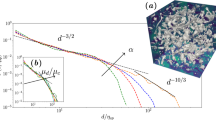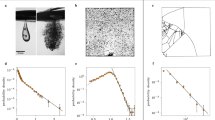Abstract
Like many natural objects, raindrops are distributed in size. By extension of what is known to occur inside the clouds, where small droplets grow by accretion of vapour and coalescence, raindrops in the falling rain at the ground level are believed to result from a complex mutual interaction with their neighbours. We show that the raindrops’ polydispersity, generically represented according to Marshall–Palmer’s law (1948), is quantitatively understood from the fragmentation products of non-interacting, isolated drops. Both the shape of the drops’ size distribution, and its parameters are related from first principles to the dynamics of a single drop deforming as it falls in air, ultimately breaking into a dispersion of smaller fragments containing the whole spectrum of sizes observed in rain. The topological change from a big drop into smaller stable fragments—the raindrops—is accomplished within a timescale much shorter than the typical collision time between the drops.
This is a preview of subscription content, access via your institution
Access options
Subscribe to this journal
Receive 12 print issues and online access
$209.00 per year
only $17.42 per issue
Buy this article
- Purchase on Springer Link
- Instant access to full article PDF
Prices may be subject to local taxes which are calculated during checkout




Similar content being viewed by others
References
Bentley, W. Studies of raindrops and raindrop phenomena. Mon. Weath. Rev. 10, 450–456 (1904).
von Lenard, P. Über regen. Meteorol. Z. 06, 92–262 (1904).
Laws, J. & Parsons, D. The relation of raindrop-size to intensity, ii. Trans. Am. Geophys. Union 24, 452–460 (1943).
Marshall, J. S. & Palmer, W. M. The distribution of raindrops with size. J. Meteorol. 5, 165–166 (1948).
Houze, R. A., Hobbs, P. V. & Herzegh, P. H. Size distributions of precipitation particles in frontal clouds. J. Atom. Sci. 36, 156–162 (1979).
Mason, B. J. The Physics of Clouds (Clarendon, 1971).
Ulbrich, W. C. A review of the differential reflectivity technique of measuring rainfall. IEEE Trans. Geosci. Remote Sensing GE-24, 955–965 (1986).
Testik, F. Y. & Barros, A. P. Towards elucidating the microstructure of warm rainfall: A survey. Rev. Geophys. 45, 1–21 (2007).
Langmuir, I. The production of rain by a chain reaction in cumulus clouds at temperature above freezing. J. Meteorol. 5, 175–192 (1948).
Falkovich, G., Fouxon, A. & Stepanov, M. Acceleration of rain initiation by turbulence. Nature 419, 151–154 (2002).
Pruppacher, H. R. & Klett, J. D. Microphysics of Clouds and Precipitation (Kluwer–Academic, 1997).
Kombayasi, M., Gonda, T. & Isono, K. Life time of water drops before breaking and size distribution of fragment droplets. J. Met. Soc. Japan 42, 330–340 (1964).
Srivastava, R. Size distribution of raindrops generated by their breakup and coalescence. J. Atmos. Sci. 28, 410–415 (1971).
Low, T. & List, R. Collision, coalescence and breakup of raindrops. Part i: Experimentally established coalescence efficiencies and fragment size distributions in breakup. J. Atmos. Sci. 39, 1591–1606 (1982).
Seinfeld, J. H. & Pandis, S. N. Atmospheric Chemistry and Physics (Wiley, 1998).
Barros, A. P., Prat, O. P., Shrestha, P., Testik, F. Y. & Bliven, L. F. Revisiting Low and List (1982): Evaluation of raindrop collision parametrizations using laboratory observations and modeling. J. Atmos. Sci. 65, 2983–2993 (2008).
Kostinski, A. B. & Jameson, A. Fluctuation properties of precipitation. Part iii. On the ubiquity and emergence of the exponential drop size spectra. J. Atmos. Sci. 56, 111–121 (1999).
Lane, W. Shatter of drops in streams of air. Ind. Eng. Chem. 43, 1312–1317 (1951).
Pilch, M. & Erdman, C. Use of breakup time data and velocity history data to predict the maximum size of stable fragments for acceleration-induced breakup of a liquid drop. Int. J. Multiphase Flow 13, 741–757 (1987).
Chou, W.-H. & Faeth, G. M. Temporal properties of secondary drop breakup in the bag breakup regime. Int. J. Multiphase Flow 24, 889–912 (1998).
Hanson, A. R., Domich, E. G. & Adams, H. S. Shock tube investigation of the break-up of drops by air blasts. Phys. Fluids 6, 1070–1080 (1963).
Ranger, A. A. & Nicholls, A. J. Aerodynamic shattering of liquid drops. AIAA J. 7, 285–290 (1969).
Fournier d’Albe, E. M. & Hidayetulla, S. M. The break-up of large water drops falling at terminal velocity in free air. Q. J. R. Meteorol. Soc. 81, 610–613 (1955).
Magarvey, H. R. & Taylor, W. B. Free fall breakup of large drops. J. Appl. Phys. 27, 1129–1135 (1956).
Magarvey, H. R. & Taylor, W. B. Shattering of large drops. Nature 177, 745–746 (1956).
Alusa, A. L. & Blanchard, D. C. Drop size distribution produced by the breakup of large drops under turbulence. J. Recherches Atmos. VII, 1–9 (1971).
Villermaux, E. Fragmentation. Annu. Rev. Fluid Mech. 39, 419–446 (2007).
Thomson, J. J. & Newall, M. A. On the formation of vortex rings by drops. Proc. R. Soc. London 39, 417–436 (1885).
Buah-Bassuah, P. K., Rojas, R., Residori, S. & Arecchi, F. T. Fragmentation instability of a liquid drop falling inside a heavier miscible fluid. Phys. Rev. E 72, 067301 (2005).
Batchelor, G. K. An Introduction to Fluid Dynamics (Cambridge Univ. Press, 1967).
Lamb, H. Hydrodynamics 6th edn (Cambridge Univ. Press, 1932).
Hinze, J. O. Fundamentals of the hydrodynamic mechanism of splitting in dispersion processes. AIChE J. 1, 289–295 (1949).
Paruchuri, S. & Brenner, M. P. Splitting of a jet. Phys. Rev. Lett. 98, 134502 (2007).
Taylor, G. I. The shape and acceleration of a drop in a high speed air stream. Collected Papers III, 457–464 (1949).
Engel, O. G. Fragmentation of water drops in the zone behind an air shock. J. Res. Nat. Bur. Stand. 60, 245–280 (1958).
Bremond, N. & Villermaux, E. Bursting thin liquid films. J. Fluid Mech. 524, 121–130 (2005).
Reyssat, E., Chevy, F., Biance, A. L., Petitjean, L. & Quéré, D. Shape and instability of free-falling liquid globules. Europhys. Lett. 34005 (2007).
Matthews, B. J. & Mason, J. B. Electrification produced by the rupture of large water drops in an electric field. Q. J. R. Meteorol. Soc. 90, 275–286 (1964).
Ulbrich, W. C. Natural variations in the analytical form of the raindrop size distribution. J. Clim. Appl. Meteorol. 22, 1764–1775 (1983).
Blanchard, D. C. & Spencer, A. T. Experiments on the generation of raindrop-size distributions by drop breakup. J. Atmos. Sci. 27, 101–108 (1970).
Liu, Y. Statistical theory of the Marshall-Palmer distribution of raindrops. Atmos. Eng. 27A, 15–19 (1993).
Jameson, A. R. & Kostinski, A. A. What is a raindrop size distribution? Bull. Am. Meteorol. Soc. 82, 1169 (2001).
Blanchard, D. C. Raindrop size distribution in Hawaiian rains. J. Meteorol. 10, 457–473 (1953).
Ohtake, T. Observations of size distributions of hydrometers through the melting layer. J. Atmos. Sci. 26, 545–557 (1969).
Gunn, K. L. S. & Marshall, J. S. The distribution with size of aggregate snowflakes. J. Meteorol. 15, 452–461 (1958).
Acknowledgements
This work has been supported by the Office National d’Études et Recherches Aérospatiales (ONERA) under contract F/20215/DAT-PPUJ and Agence Nationale de la Recherche (ANR) through grant ANR-05-BLAN-0222-01.
Author information
Authors and Affiliations
Contributions
E.V. designed and carried out the experiments, analysed the data and wrote the paper; B.B. helped in the experiments and image processing.
Corresponding author
Supplementary information
Supplementary Information
Supplementary Information (PDF 61 kb)
Supplementary Movie
Supplementary Movie (AVI 66567 kb)
Rights and permissions
About this article
Cite this article
Villermaux, E., Bossa, B. Single-drop fragmentation determines size distribution of raindrops. Nature Phys 5, 697–702 (2009). https://doi.org/10.1038/nphys1340
Received:
Accepted:
Published:
Issue Date:
DOI: https://doi.org/10.1038/nphys1340
This article is cited by
-
The impact of rainfall on the sea surface salinity: a mesocosm study
Scientific Reports (2024)
-
Suppression of hollow droplet rebound on super-repellent surfaces
Nature Communications (2023)
-
The interaction of droplet dynamics and turbulence cascade
Communications Physics (2023)
-
Drop size and rain rate characteristics of Indian monsoon rainwater
Journal of Earth System Science (2023)
-
Raindrop Size Distribution Measurements at High Altitudes in the Northeastern Tibetan Plateau during Summer
Advances in Atmospheric Sciences (2023)



